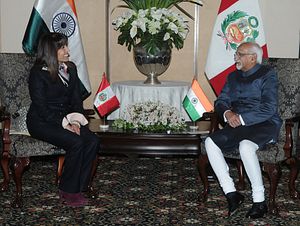In South America, the strength of the Colombian and Peruvian economies has boosted the region’s economic confidence. It is further emboldened with the election last year of Pedro Pablo Kuczynski, the new president of Peru known for his pro-business bent. Indeed, trade liberalization is already on the table. Economic prospects look bright for Peru with a projected GDP growth rate of 4 percent in 2017, the highest in the region. Peru’s ambitious economic plans are quite evident as it is looking beyond its region and embarking optimistically on its Asian journey.
One of the most hyped events scheduled to take place in India- Latin America economic diplomacy this year is the free trade talks between India and Peru, which have been confirmed to take place in July this year. A Joint Study Group (JSG) was set up by the two countries in January 2015 to create a feasibility study, which in October 2016 gave a nod to the desirability of a free trade agreement (FTA). After the feasibility report was approved, there were various speculations in relation to how soon the talks could start, with the expected state date moving from the first quarter of 2017 to June and finally July 2017.
The proposed FTA is the first of its kind India would have with any Latin American country. In some quarters, an eventual India-Peru FTA is expected to include the neighboring countries of Peru as well in the near future. It is rather optimistic to expect this, as nothing high profile seems to be occurring in the political framework between India and Latin America.
From Peruvian side, Peru’s South-South trade initiatives, which also include its participation in the Trans-Pacific Partnership (TPP), and its interest in the Regional Comprehensive Economic Partnership (RCEP), are likely to get another lift. In fact, Peru already has a free trade agreement with China that was signed in 2009 and put in effect the following year. A Peruvian free trade agreement with India would enhance its economic position.
The talks, if successful, would lower tariff barriers on both sides – with much expected from the Indian side, where the tariff barriers are high. India-Peru trade is already in the billion dollar club, and has been since 2012. With the finalization of a free trade deal, Peruvian exports to India are expected to increase by 12 percent. Most prominently, Peru is rich in natural resources that India needs. India’s heavy industries and technological capability, including the IT sector, would prove the partnership to be mutually beneficial.
However, it is too early to predict the benefits. Stagnation has been one of the visible aspect of India’s FTAs. Similar free trade agreements and other trade agreements have been signed with other countries in the past, but with limited outcomes. India’s referential Trade Agreements (PTA) with Chile and MERCOSUR (the Southern Common Market, encompassing Brazil, Argentina, Uruguay, and Paraguay) have facilitated trade, but with a limited scope. To more fully explore the potential, an expanded PTA between India and Chile was implemented in May this year. Also, to conclude negotiations, India also would have to introduce substantial reforms on its side, which still remains relatively closed per international standards.
Moving beyond the free trade of goods and services, there are countless asymmetries prevalent in current business patterns that will also need to be addressed for India to make the most of trade agreements with South America. Broadly speaking, the lines of credit and trade concessions offered by China are far more generous than what the Export Import Bank of India (EXIM) can viably offer. Even when it comes to the decision-making process, Chinese investments (largely managed by state-led institutions) can efficiently and almost immediately execute plans, as compared to the bottlenecks in the bureaucratic set-up in India. These are significant aspects that need to be addressed.
India and China, though not in direct competition, have similar needs in Latin America, i.e. raw materials and primary goods. India can deploy tactics of joint bidding with China, as in the past, rather than competing against Beijing.
It is likely that during such a process India would be entering into numerous environmentally sensitive sectors of trade. However, due to the bad experience of Chinese business corporations, India has to be extra sensitive so as not dent its image in the region. In the past, there have been numerous cases of joint ventures being terminated owing to mismanagement and “unrealistic expectations” from both the sides.
India already has good but underexplored trade relations with Mexico, Venezuela and Chile, apart from its alignment with Brazil. With the India-Peru free trade discussions, India would be able to move ahead of the stereotype of seeing Latin America through the Brazilian lens. India coming closer to Peru would add a new and significant trade partner to its ambit, just as the Brazilian economy is contracting. Before the 2017 BRICS Summit to be held in Xiamen, China, this step would add to India’s strategy of penetrating the Latin American region more deeply.
Binay Prasad is a Ph.D. Candidate in Latin American Studies Programme at Jawaharlal Nehru University, New Delhi.

































